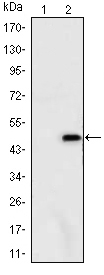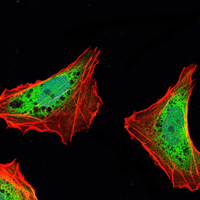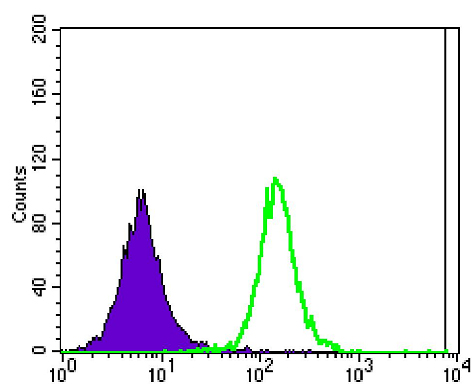Ataxin-1 Monoclonal Antibody
- Catalog No.:YM0051
- Applications:WB;IHC;IF;FCM;ELISA
- Reactivity:Human
- Target:
- Ataxin-1
- Fields:
- >>Notch signaling pathway;>>Spinocerebellar ataxia;>>Pathways of neurodegeneration - multiple diseases
- Gene Name:
- ATXN1
- Protein Name:
- Ataxin-1
- Human Gene Id:
- 6310
- Human Swiss Prot No:
- P54253
- Mouse Swiss Prot No:
- P54254
- Immunogen:
- Purified recombinant fragment of human Ataxin-1 expressed in E. Coli.
- Specificity:
- Ataxin-1 Monoclonal Antibody detects endogenous levels of Ataxin-1 protein.
- Formulation:
- Liquid in PBS containing 50% glycerol, 0.5% BSA and 0.02% sodium azide.
- Source:
- Monoclonal, Mouse
- Dilution:
- WB 1:500 - 1:2000. IHC 1:200 - 1:1000. IF 1:200 - 1:1000. Flow cytometry: 1:200 - 1:400. ELISA: 1:10000. Not yet tested in other applications.
- Purification:
- Affinity purification
- Storage Stability:
- -15°C to -25°C/1 year(Do not lower than -25°C)
- Other Name:
- ATXN1;ATX1;SCA1;Ataxin-1;Spinocerebellar ataxia type 1 protein
- Molecular Weight(Da):
- 87kD
- References:
- 1. Nature. 2008 Apr 10;452(7188):713-8.
2. Biochem Biophys Res Commun. 2008 Jun 27;371(2):256-60.
3. Indian J Med Res. 2007 Nov;126(5):465-70.
- Background:
- ataxin 1(ATXN1) Homo sapiens The autosomal dominant cerebellar ataxias (ADCA) are a heterogeneous group of neurodegenerative disorders characterized by progressive degeneration of the cerebellum, brain stem and spinal cord. Clinically, ADCA has been divided into three groups: ADCA types I-III. ADCAI is genetically heterogeneous, with five genetic loci, designated spinocerebellar ataxia (SCA) 1, 2, 3, 4 and 6, being assigned to five different chromosomes. ADCAII, which always presents with retinal degeneration (SCA7), and ADCAIII often referred to as the `pure' cerebellar syndrome (SCA5), are most likely homogeneous disorders. Several SCA genes have been cloned and shown to contain CAG repeats in their coding regions. ADCA is caused by the expansion of the CAG repeats, producing an elongated polyglutamine tract in the corresponding protein. The expanded repeats are variable in size and unstable, usually increasing in size when transmitted
- Function:
- alternative products:At least 2 isoforms are produced,disease:Defects in ATXN1 are the cause of spinocerebellar ataxia type 1 (SCA1) [MIM:164400]; also known as olivopontocerebellar atrophy I (OPCA I or OPCA1). Spinocerebellar ataxia is a clinically and genetically heterogeneous group of cerebellar disorders. Patients show progressive incoordination of gait and often poor coordination of hands, speech and eye movements, due to cerebellum degeneration with variable involvement of the brainstem and spinal cord. SCA1 belongs to the autosomal dominant cerebellar ataxias type I (ADCA I) which are characterized by cerebellar ataxia in combination with additional clinical features like optic atrophy, ophthalmoplegia, bulbar and extrapyramidal signs, peripheral neuropathy and dementia. SCA1 is caused by expansion of a CAG repeat in the coding region of ATXN1. Longer expansions result in earlier
- Subcellular Location:
- Cytoplasm . Nucleus . Colocalizes with USP7 in the nucleus. .
- Expression:
- Widely expressed throughout the body.
- June 19-2018
- WESTERN IMMUNOBLOTTING PROTOCOL
- June 19-2018
- IMMUNOHISTOCHEMISTRY-PARAFFIN PROTOCOL
- June 19-2018
- IMMUNOFLUORESCENCE PROTOCOL
- September 08-2020
- FLOW-CYTOMEYRT-PROTOCOL
- May 20-2022
- Cell-Based ELISA│解您多样本WB检测之困扰
- July 13-2018
- CELL-BASED-ELISA-PROTOCOL-FOR-ACETYL-PROTEIN
- July 13-2018
- CELL-BASED-ELISA-PROTOCOL-FOR-PHOSPHO-PROTEIN
- July 13-2018
- Antibody-FAQs
- Products Images

- Western Blot analysis using Ataxin-1 Monoclonal Antibody against HEK293 (1) and ATXN1-hIgGFc transfected HEK293 (2) cell lysate.

- Immunohistochemistry analysis of paraffin-embedded ovarian cancer tissues (left) and lung cancer tissues (right) with DAB staining using Ataxin-1 Monoclonal Antibody.

- Immunofluorescence analysis of NTERA-2 cells using Ataxin-1 Monoclonal Antibody (green). Blue: DRAQ5 fluorescent DNA dye. Red: Actin filaments have been labeled with Alexa Fluor-555 phalloidin.

- Flow cytometric analysis of Jurkat cells using Ataxin-1 Monoclonal Antibody (green) and negative control (purple).



